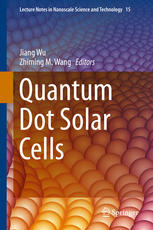

Most ebook files are in PDF format, so you can easily read them using various software such as Foxit Reader or directly on the Google Chrome browser.
Some ebook files are released by publishers in other formats such as .awz, .mobi, .epub, .fb2, etc. You may need to install specific software to read these formats on mobile/PC, such as Calibre.
Please read the tutorial at this link: https://ebookbell.com/faq
We offer FREE conversion to the popular formats you request; however, this may take some time. Therefore, right after payment, please email us, and we will try to provide the service as quickly as possible.
For some exceptional file formats or broken links (if any), please refrain from opening any disputes. Instead, email us first, and we will try to assist within a maximum of 6 hours.
EbookBell Team

5.0
110 reviewsThe third generation of solar cells includes those based on semiconductor quantum dots. This sophisticated technology applies nanotechnology and quantum mechanics theory to enhance the performance of ordinary solar cells. Although a practical application of quantum dot solar cells has yet to be achieved, a large number of theoretical calculations and experimental studies have confirmed the potential for meeting the requirement for ultra-high conversion efficiency. In this book, high-profile scientists have contributed tutorial chapters that outline the methods used in and the results of various quantum dot solar cell designs, including quantum dot intermediate band solar cells, hot electron quantum dot solar cells, quantum-dot sensitized solar cells, colloidal quantum dot solar cells, hybrid polymer-quantum dot solar cells, and MEG quantum dot solar cells. Both theoretical and experimental approaches are described. Quantum Dot Solar Cells helps to connect the fundamental laws of physics and the chemistry of materials with advances in device design and performance. The book can be recommended for a broad audience of chemists, electrical engineers, and materials scientists, and is suitable for use in courses on materials and device design for advanced and future optoelectronics.